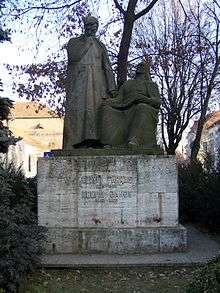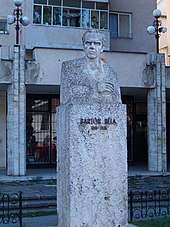Márton Izsák
Márton Izsák (István) (English: Martin Isaac ) was a prolific Transylvanian Jewish sculptor of Hungarian descent, noted personality and recipient of the honorary citizenship award from the city of Târgu Mureș.
Márton Izsák | |
|---|---|
 The Bolyai Statue (hungarian), Târgu Mureș | |
| Born | 12 April 1913 |
| Died | 1 February 2004 (aged 90) |
| Nationality | Romania |
| Occupation | sculptor |
| Years active | 1947–1983 |
The son of Izsák Jakab (a government official, professional soldier and eventual store owner), by arranged marriage to Friedman Vilma, Márton was born in Gălăuțaș. After his family home in Gheorgheni burned down in World War I, his family spent some years in Petele before eventually settling down in Târgu Mureș.[1][2][3]
After moving to the city, he spent some time apprenticing in furniture making under an artist named Rózsa Géza,[1] who noted Márton's artistic talent. At the artist's behest, Márton's father enrolled him in an arts program, and he spent the next 3 years learning how to carve at the Industrial High School in Târgu Mureș, but before finishing he was invited by Rózsa to complete highschool, and then continue to an arts degree, at the College of Applied Arts in Budapest, graduating (notably early for his age) in 1933. While at the College, he studied under notable sculptors Imre Simay and Lajos Mátrai.
In the late 1930s he returned home to Târgu Mureș, where he remained until his deportation (despite his fathers' world war I medals, which should have afforded some protection[3]) at the beginning of World War II. He gained recognition and eventually presented his works in personal exhibitions in 1936 and in 1937.
During the war, he lost 25 relatives, including his mother[3], to death camps. After his return to the city from labour camp in 1944, he worked as well recognized instructor and eventually art director at the acclaimed Liceul Vocational de Artâ (art high school) in Târgu Mureș 1945 to 1974.[2][4]
During his time at the art school, he produced many notable works, including several collaborations with István Csorvássy. His Monument to the Deportees, erected in Dej in front of the local Orthodox synagogue is one of the earliest Holocaust memorials to be erected in Europe[3], and memorializes ~7000 jews relocated to the nearby Dej ghetto and eventually deported and killed at Auschwitz-Birkenau.[5] Many of his other works still are on display in several cities, but primarily in Târgu Mureș – including the notable "Two Bolyai" in Bolyai Square in Târgu Mureș.[2]
The mysterious overnight removal, in 1962[6][7] of his statue of Stalin, erected just five years earlier in 1957, is remembered as signifying the metaphorical end of a Soviet Union domination of Romania during De-Stalinization in Romania.[8]
In 2003, a public Holocaust memorial was erected in Târgu Mureș, based on a cast and plans originally produced for Dej in 1947.[3][9] Shortly before his death, he was ordained as ro:Cetățean de onoare (Honorary Citizen, an order recognizing civic contribution) for the city.[10]
Mysterious disappearance of the Stalin statue in 1962
According to local tales, the Târgu Mures statue was not officially destroyed – it simply disappeared overnight, without indication of where it went or what was done with it. All this occurred against a background of significant political upheaval, including the start and end of the Magyar Autonomous Region, De-Stalinization in Romania, and Romania's gradual distancing from the Warsaw pact.[11]
The event has entered public folklore, and to this day continues to be a subject of conversation and the source of several urban myths – for example, the popular idea that the state was originally meant to contain a library in its base (which is also a myth related to the Bucharest statue), or that the library was actually constructed, still currently exists. Some claim the statue is still stored inside.[12]
Selected works[2]

- Monument to the Deportees (Bronze, 1947, Dej)[3]
- Wedding customs (relief, 1951, Sfântu Gheorghe, theater facade)
- Nicolae Balcescu (bust, in Sfântu Gheorghe)[13]
- István Szentgyörgyi (1953, Târgu Mureş, in front of the College of Theater)
- Stalin (1955, Târgu Mureş with István Csorvássy; demolished in 1962)[8]
- Farkas Bolyai and János Bolyai (aka. The Two Bolyai, The Bolyai Statue), in front of the Liceul Teologic Reformat "Bolyai Farkas" in Târgu Mures, with Csorvássy István)
- "Unknown Soldier Monument" (bronze, 1963 to 1964, Târgu Mures, War Memorial, Main Square, with Csorvássy István)[8]
- The poet Salamon Ernõ (20 February 1968, in front of Lieceul Teoretic Salamon Ernõ, Gheorgheni)[14]
- Mihai Eminescu (1969, 1989 Târgu Mures)
- Andor Bernath (1974, Saint John the Baptist Church, Târgu Mureș)
- Béla Bartók ( bust, 1980, Târgu Mures)
- George Enescu statue composition (1983, Târgu Mures)
- Holocaust Memorial (2003, Târgu Mures)[9][3]
References
| Wikimedia Commons has media related to Márton Izsák. |
- Molnár Ildikó (2002). "Izsák Márton a műtermében (Izsák Márton in his studio)". Centropa. Retrieved 19 September 2019.
- "List of notable works listed on artportal.hu". Archived from the original on 3 October 2008. Retrieved 21 September 2019.
- Tibori-Szabó, Zoltán (May 2017). "Memorialization of the Holocaust in Transylvania during the early post-war period". Journal of Southeast European and Black Sea Studies. 17 (2): 10. doi:10.1080/14683857.2017.1324262. Retrieved 20 September 2019.
- János Kristof, Zoltán (6 November 2013). "From easel to professorship. The creation and consolidation of hungarian professional fine arts education in transilvania" (PDF). Historia Actual Online: 137–145. ISSN 1696-2060. Retrieved 20 September 2019.
- "Holocaust Memorial in Dej". Gedenkstättenportal zu Orten der Erinnerung in Europa. Berlin, Germany: Stiftung Denkmal für die ermordeten Juden Europas. Retrieved 20 September 2019.
- Bottoni, Stefano (2008). Sztálin a székelyeknél: A Magyar Autonóm Tartomány története (1952–1960) [Stalin among the Szeklers: A history of the Hungarian Autonomous Region (1952–1960)] (in Hungarian). Csíkszereda: Pro-Print Könyvkiadó. ISBN 978-973-84-6880-1.
- Bottoni, Stefano (2010). Transilvania roşie. Comunismul român şi problema naţională 1944–1965 (in Romanian). Cluj-Napoca: Editura Institutului pentru Studierea Problemelor Minorităţilor Naţionale: Kriterion. p. 289. ISBN 978-606-92512-0-1. ISBN 978-973-26-1013-8
- Bottoni, Stefano (29 May 2018). "3". Stalin's Legacy in Romania: The Hungarian Autonomous Region, 1952–1960. p. 135. ISBN 9781498551229.
- "Holocaust Memorial in Târgu Mures". Gedenkstättenportal zu Orten der Erinnerung in Europa. Berlin, Germany: Stiftung Denkmal für die ermordeten Juden Europas. Retrieved 20 September 2019.
- Antal Erika (12 June 2013). "Közös, baráti emlékezés Marosvásárhely szobrászára". Maszol.
- Raymond L. Garthoff (Spring 1995). "When and Why Romania Distanced Itself from the Warsaw Pact". Cold War International History Project Bulletin. No. 5. p. 111.
- Ana-Maria Onisei. "Statuia lui Stalin şi conflictul româno-maghiar, topite în artă". historia.ro (in Romanian). Retrieved 21 September 2019.
- "Destination: Romania / Covasna County – Overview". Romania. 7 April 2014. Retrieved 21 September 2019.
- "Salamon Ernő statue", statuemap.com. Retrieved 21 September 2019